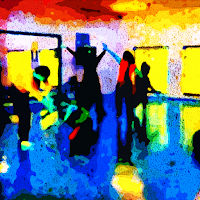Hemos empezado este mes explorando el coaching del movimiento. El papél de usar el coaching, donde se divide el grupo en parejas y toman turnos en el papel de coach, puede ser muy valioso en expander el rango de juego de todos, aparte de aportar aclaraciones en las elecciones aestéticas/creativas del danzante. Puede servir tanto para que el/la bailarin/a pueda reconocer y corporizar hacía donde pide ir su danza, ampliando lo que ya está presente en forma incipiente, tanto como proveerle con recursos que son completamente nuevos en casos donde el rango de movimiento puedar estar auto-limitado.
Utilizando los sencillos prinicipios de espacio, tiempo y fuerza, hasta un participante nuevo al coaching trabajando con alguien nuevo a la danza pueden entenderse. Después de que cada partipante se caliente y desarrolle una frase en movimiento desarrollado desde los tres niveles de experiencia (físico, emocional y mental), los participantes trabajan en parejas, uno como coach y uno como balarín y luego cambian sus papeles.
El coach puede pedir lo que desean ver en términos de espacio, velocidad/rítmo, y fuerza (movimientos fuertes o ligeros). Pero el coach primero necesita observar, ser testigo de la danza del otro. Observar y sentir la danza desde una sensibidad de los tres niveles para poder recoger información real y personal (no génerica) de la expresión de la danzante que tienen delante. el coaching se convierte en un camino para desarrollar su propia sensibilidad, discernimiento, y responsabilidad—la capacidad de discernir y responder al estar presentes y conscientes. Sólo así puede tener un significado pertinente y significativa a la persona y la danza que quiere emergir.
We have started this month exploring coaching movement. The role of coaching one another in dance can be very valuable as encouragement to expanding range of play for all, but can also aid in making important clarificaciones in the aesthetic and creative choices of the dancer. It can both be used to help the dancer recognize and embody where the essence of their dance is asking to go by emphasizing what is present in incipient form, as well as to provide entirely new resources where the range of movement may be self-limited.
Using the simple principles of space, time and force, even a participant who is new to coaching working with someone new to dancing can make themselves understood. After intially having each participant warm up and then develop a frase of movement developed from three leveles of experience (physicial, emotional and mental), the participants work in pairs, one as a coach, one as dancer and then they change roles.
The coaches can ask for what they would like to see in terms of space, speed/rhythm, and force (strong vs light movements). But first the coach must observe, be a witness to the dance of the other. They need to observe and feel the dance from their own sensitivity on the three leveles of awareness so that they may gather real, personal information (not generic) about the expression of the dancer they have in front of them. Coaching becomes a path towards developing their own sensitivity, discernment and responsibility—the ability to disceren and respond by being present and aware. Only in that way can it have pertinent significant meaning for the person and the dance that wants to emerge.

No hay comentarios:
Publicar un comentario